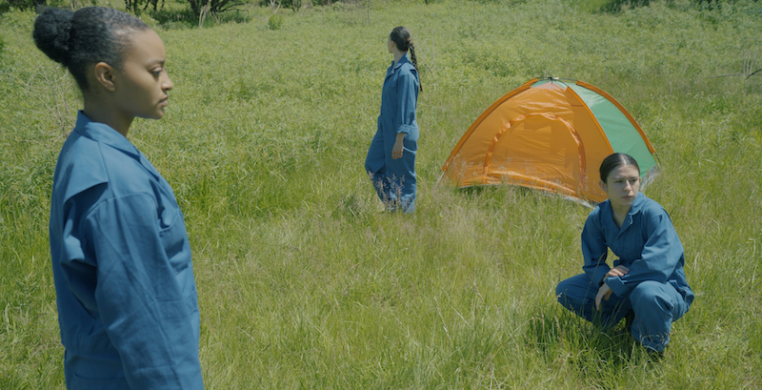I experienced Hubbard Street Dance Chicago’s “Greener Grass,” directed and choreographed by Jie-Hung Connie Shiau, virtually at my kitchen table. “Greener Grass” concludes Hubbard Street’s all-virtual season of dance films, presented for free on their website. The rain outside my window added a gorgeous texture to the erratic and experimental soundscape scored by Jerome Begin—my son eating mandarin oranges in the peripheral vision of my real life, complemented by the three women clad in blue “Orange is the New Black” style jumpsuits surveying the open emerald fields on my screen. I was not quite sure where their careful walking would lead, but the eerie soundtrack coupled with the arbitrary camping tent, exposing a lifeless body hinted toward the discomfort that lay ahead.
Hubbard Street Dance Chicago is one of those familiar yet unfamiliar friends. I think I know them because I’ve taken many dance classes over the course of my career at their former home, Lou Conte Dance Studio. A number of those classes were led by their company members and in my head, I thought I had a pretty good sense of who they were. “Greener Grass” proves me wrong, urging me to listen to a new song on a familiar album.
As a response to re-education camps designed by Chinese government for Muslim groups, “Greener Grass” examines the sterile and inhumane conditions of cultural erasure. Cultural erasure is defined as the gradual removal of various traditions and customs from society. It is a violent act that has taken place throughout the world for centuries. In order to eradicate it, we must be still and recognize all the ways we feed the beast in our day-to-day survival. Using post-contemporary choreography, Shiau does just that; we are taken on a zombified journey dominated with rooted athleticism and functional lifts. Monotonous relay races and unusual partnering flood the screen in a pedestrian fashion. If these descriptions sound boring, it’s not pointed at the performance but rather cultural erasure and its mundane odor. What I know to be dance—vibrant, dynamic, spiritual, otherworldly—or what I thought I knew to be Hubbard Street—smooth, modern lines and quickness—is often challenged in this film.
Partnering looks like clunky drags across the floor or third arms behaving like tentacles rubbing off makeup residue in an up close shot of dancer Jacqueline Burnett. This profound scene reminds me of medusa and the ever enduring power of the feminine, penetrating patriarchal structures throughout the world. The image was followed by the voice of Hubbard Street dancer Alysia Johnson narrating a childhood memory of when she waxed off one eyebrow and her mother had to draw it back on. Following the charade of arms, the remaining nine company members emerged from the back, repeating a pattern reminiscent to the game “Red Light, Green Light” as they sprinted from one perimeter to the other, attempting to escape, return, ponder and repeat. The blue jumpsuits added to the feeling of a hopeless asylum, signaling that perhaps this indoor playground was a trap—re-education systems are indeed a trap, physically and mentally. No one goes anywhere.
The school-to-prison pipeline also was heavy on my mind as I watched Abdiel Figueroa Reyes cautiously vogueing in a four walled room in the third scene. As “Greener Grass” aimed to shed light on re-education camps affecting the Muslim population in China, I found a point of correlation through the school-to-prison pipeline that disproportionately affects Black and brown youth here in America. The film end how it started, in grassy lots with focused humans determined to flourish in the freedom of nature. I do not have an answer to completely explain what I experienced visually. I wanted to see the piece again to capture the details I missed. I was unsure of how I felt about the subject matter and how to articulate all these unfamiliar sentiments. What I could place was a sense of curiosity and ease as the film came full circle, returning me to real life with my toddler spinning to ambient sounds of helicopters and insects mating on sweltering Summer days, on my screen. I was grateful to be home and to know that my first dance home was doing the work to make this place more inhabitable in the present and for the generations to follow.


